Fastest Speed That a Human Has Traveled
How fast could humans travel safely through space?
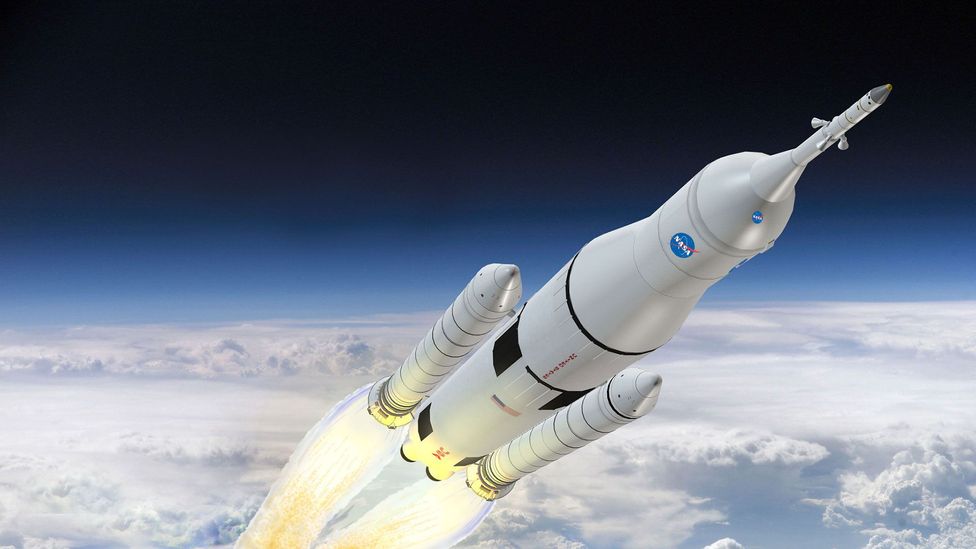
The electric current speed tape has stood for 46 years. When will it be browbeaten, asks Adam Hadhazy.
W
We humans are obsessed with speed. Recent months, for example, brought news that students in Germany have broken the tape for the fastest accelerating electric auto, and that the United states of america Air Force plans to develop hypersonic jets that would travel at more than than five times the speed of audio – that's speeds in excess of three,790mph (half-dozen,100km/h).
Those jets would carry no crew – just non considering humans can't travel at such high speeds. In fact, humans have already travelled many times faster than Mach five. Is there some limit, however, beyond which hurtling bodies tin no longer bear the strain of speed?
The current human being speed record is shared equally by the trio of astronauts who flew Nasa'southward Apollo 10 mission. On their way back from a lap around the Moon in 1969, the astronauts' capsule hit a peak of 24,790mph (39,897km/h) relative to planet Earth. "I remember a hundred years agone, nosotros probably wouldn't take imagined a human could travel in space at almost 40,000 kilometres per hour," says Jim Bray of the aerospace firm Lockheed Martin.

Even green-energy cars are getting race-circuit fast; but humanity volition have to get a lot faster to explore the Universe (Credit: Stuttgart Greenish Team)
But we could shell that record relatively soon. Bray is the director of the Orion coiffure module project for America's space agency, Nasa. The Orion spacecraft is intended to conduct astronauts into a low Globe orbit, and is a good bet for the vehicle that will interruption the 46-year-old tape for the fastest nosotros've ever travelled.
The Space Launch Organization, a new rocket that volition ferry the Orion spacecraft aloft, should accept its beginning crewed mission in 2021 – a flyby of an asteroid captured in lunar orbit – with a months-long mission to Mars so in the offing. At nowadays, designers envision Orion's typical maximum velocity in the neighbourhood of 19,900mph (32,000km/h). Merely the Apollo 10 speed record could be surpassed, even just sticking with Orion's base configuration. "Orion is designed for many different destinations over its lifetime," says Bray. "Its speed could well go a lot higher than we plan at present."
Fifty-fifty Orion won't correspond the tiptop of our speed potential, though. "In that location is no real practical limit to how fast we can travel, other than the speed of low-cal," says Bray. Lite zips along at well-nigh a billion kilometres per hour. Can we hope to safely bridge the gap from 40,000kph to those speeds?
Surprisingly, speed – defined as a rate of motion – in of itself is not at all a problem for u.s.a. physically, so long as it's relatively constant and in one direction. Therefore, humans should – in theory – exist able to travel at rates just curt of the "Universe'south speed limit": the speed of light.
But assuming we tin can overcome the considerable technological obstacles in building faster spacecraft, our fragile, mostly-h2o bodies volition accept to fence with significant new hazards that come with such high-speed travel. Speculative dangers could ascend, too, if humans achieve faster-than-light travel, either past exploiting loopholes in known physics or through prototype-shattering discoveries.
Withstanding One thousand-forces
Notwithstanding nosotros reach speeds in excess of 40,000kph, we volition have to ramp upward to (and down from) them patiently. Rapid acceleration and deceleration tin be lethal to the human organism: witness the bodily trauma in car crashes as we go from a mere tens-of-kilometres-per-hr prune to zero in the span of seconds. The reason? A property of the Universe known as inertia, whereby whatsoever object with mass resists change to its state of motion. The concept is famously expressed in Newton's first law of motion as "an object at rest stays at residue and an object in motion stays in motion with the same speed and in the aforementioned direction unless acted upon by an outside force".
"For the human torso, constant is good," explains Bray. "It'southward dispatch we have to worry about."
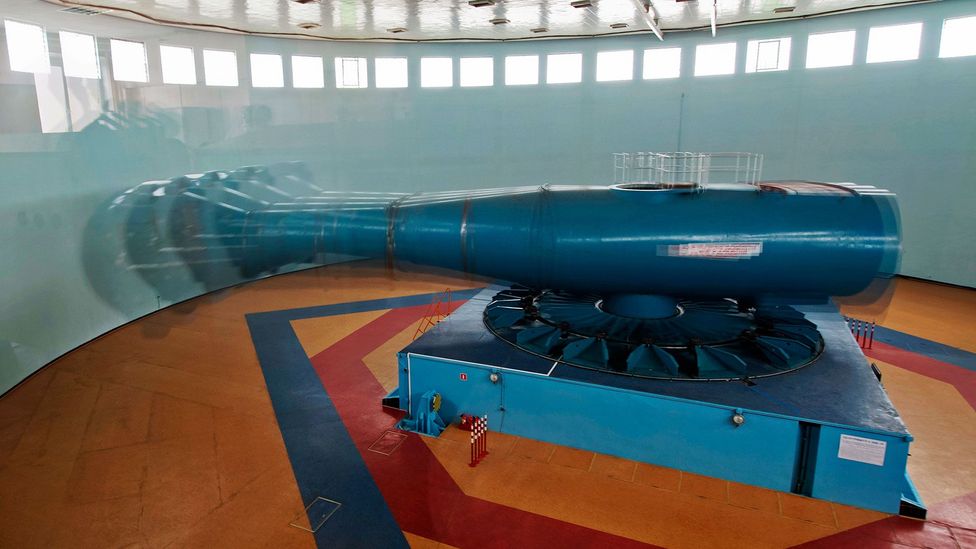
Pilots are tested in centrifuges such as these to see how many Gs their bodies can withstand (Credit: Scientific discipline Photo Library)
Almost a century ago, the invention of sturdy shipping that could manoeuvre at speed led to pilots reporting strange symptoms related to speed and directional changes. These included temporary vision loss and the sensation of either leadenness or weightlessness. The cause is G-forces, otherwise called gravitational forces, or fifty-fifty simply Gs. These are units of accelerative strength upon a mass, such as a human being body. Ane One thousand is equal to the pull of Earth's gravity toward the planet's centre at 9.8 metres per second squared (at sea level).
G-forces experienced vertically, from head to toe or vice versa, are the ones that can be truly bad news for pilots and passengers. Blood pools in the heads of those undergoing negative Gs, from toe to head, causing an engorged sensation like when nosotros do a handstand. "Ruddy out" sets in as blood-swelled, translucent lower eyelids rising up to embrace the pupils. Conversely, when dispatch is positive, from head down to foot, the eyes and brain go starved of oxygen equally blood collects in the lower extremities. Dimmed vision called "grayness out" initially occurs, followed by total vision loss, or "blackout". These high Gs tin can progress to outright faints, dubbed One thousand-induced loss of consciousness (GLOC). Many aviation deaths result from pilots blacking out and crashing.
The average person can withstand a sustained strength of almost five Gs from caput to toe before slipping into unconsciousness. Pilots wearing special high-G suits and trained to flex their torso muscles to go along blood from whooshing out of their heads can nevertheless operate their aircraft at near nine Gs. "For short periods, the human body can have much college than nine Gs," says Jeff Sventek, the Executive Director of the Aerospace Medical Association, based in Alexandria, Virginia. "But to sustain that for long flow of time, not too many humans can do it."
If just for mere moments, we humans can tolerate way stronger Gs without grievous injury. The record for momentary Gs is held by Eli Beeding Jr, an American Air Force captain. He rode a rocket-powered sled backwards in 1958 and recorded a pummelling 82.6Gs on his breast accelerometer as the sled accelerated to about 34mph (55kph) in one-10th of a second. Beeding blacked out but suffered piddling more than back bruises, in a remarkable demonstration of the body's resilience.
Out into space
Astronauts, depending on their vehicle, have also experienced fairly high Gs – betwixt three and eight on takeoffs and atmospheric re-entries, respectively. These G-forces are mostly benign forepart-to-back Gs, cheers to the smart exercise of strapping spacegoers into seats facing their direction of travel. Once at a steady cruising speed of about 16,150mph (26,000kph) in orbit, astronauts no more feel their speed than do passengers on a commercial airplane.
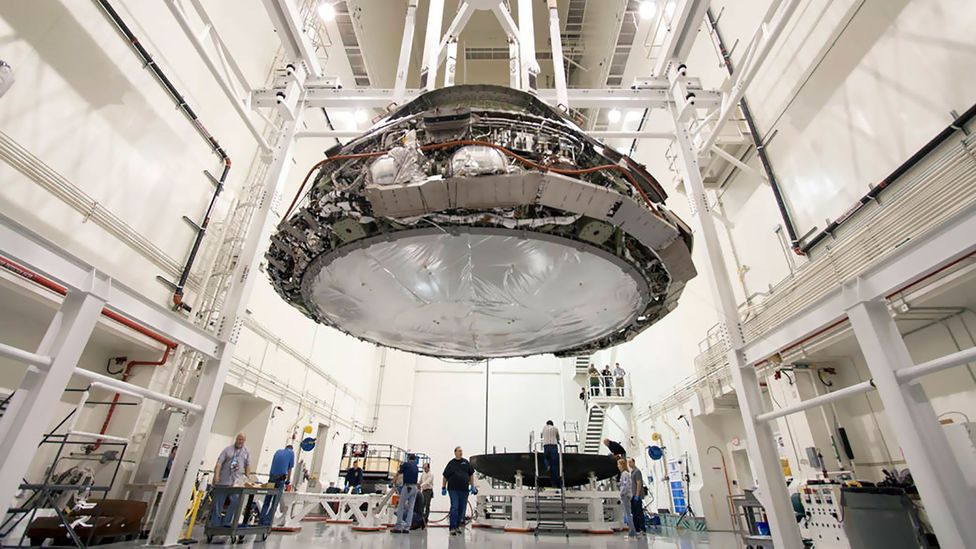
The Orion spaceship has to have shielding a foot thick in places because of the danger of minimeteorids (Credit: Nasa)
If G forces aren't a problem for Orion's longer duration missions, pocket-size space rocks – "micrometeoroids" – might be. These grain-size bits tin can reach impressively devastating speeds of nearly 186,000mph (300,000km/h). To protect the vessel and its coiffure, Orion has a protective outer layer varying in places from eighteen to 30cm thick, plus other shielding and clever equipment placement. "So we don't lose a disquisitional flight system, for the entire spacecraft we have to await at which angle a micrometeoroid can come up from," says Bray.
To be certain, micrometeoroids are not the merely hindrance to future space missions where higher human being travel speeds would likely come up into play. On a Mars mission, other practical issues will demand to be addressed, including the crew'southward food supply and their increased lifetime cancer risks from cosmic radiation exposure. Shortening travel times, though, would mitigate these issues, making a go-faster approach very desirable.
Space travel, the next generation
This demand for speed will pose fresh obstacles. The new Nasa vessels that might threaten Apollo 10'southward speed tape volition still rely on tried-and-true, chemical rocket propulsion systems, used since the very showtime space missions. Merely such systems have severe speed limitations considering of the low amounts of energy they release per unit of fuel.
So, in order to attain significantly faster travel speeds for humans spring for Mars and across, scientists recognise that new approaches will be required. "The systems we accept today are going to be good enough to get us there," says Bray, "just you would like to run across a revolution in propulsion."
Eric Davis, a senior research physicist at the Institute for Advanced Studies at Austin and contributor to Nasa's Breakthrough Propulsion Physics Program, a six-year-long research project that ended in 2002, outlines three of the near promising means – assuming conventional physics – for getting humanity upward to reasonable interplanetary travel speeds. In cursory, they are the energy-releasing phenomena of fission, fusion and antimatter annihilation.
The commencement method is the splitting of atoms, as is done in commercial nuclear reactors. The second, fusion, combines atoms into heavier atoms – the reaction that powers the Dominicus, and a technology that remains tantalisingly out of reach; "always 50 years away", as an former industry motto goes.
"These technologies are advanced," says Davis, "but they're conventional physics and accept been well-established since the dawn of the Diminutive Age." Optimistically, diverse propulsion systems based on fission and fusion concepts could theoretically accelerate a vessel upward to 10% of the speed of lite – a cool 62,000,000mph (100,000,000km/h).
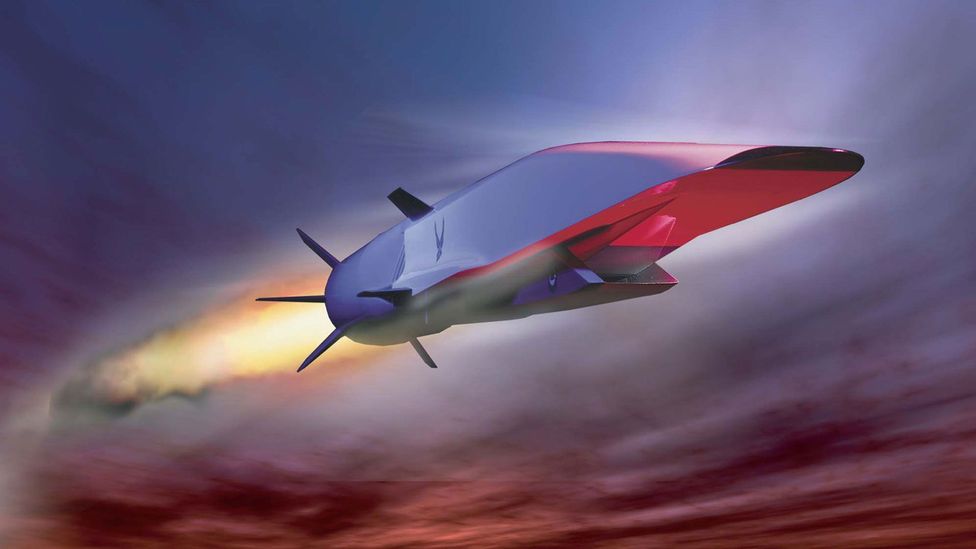
Flying at Mach 5 is not a problem - simply 60 one thousand thousand per hour presents different problems (Credit: US Air Force)
The far-and-abroad best case for powering fast spacecraft is antimatter, the doppelganger to regular affair. When the two matters make contact, they obliterate each other as pure energy. Technologies to generate and store (admittedly minuscule) quantities of antimatter exist today. All the same product of antimatter in useful amounts would need defended, adjacent-generation facilities, and engineering challenges galore would loom for the intended spacecraft. But Davis says plenty of good ideas are on the drawing lath.
With antimatter-fuelled engines, spacecraft could advance over periods of months or years to very high percentages of the speed of lite, keeping Gs to a tolerable level for occupants. These fantastic new speeds, however, would usher in fresh dangers for the human being body.
An energetic hail
At several hundreds of millions of kilometres per hour, every mote in space, from stray hydrogen gas atoms to micrometeoroids, becomes in effect a high-powered bullet ploughing into a ship's hull. "When you're going at loftier speeds, that'due south equivalent to a particle moving at you lot at loftier speeds," says Arthur Edelstein. He worked with his late male parent, William Edelstein, a professor of radiology at the Johns Hopkins Academy Schoolhouse of Medicine, on a 2012 paper exploring the effects of cosmic hydrogen atoms on ultrafast spaceflight.
Although only present at a density of effectually one atom in a cubic centimetre, the cosmos's ambient hydrogen would translate into a bombardment of intense radiations. The hydrogen would shatter into subatomic particles that would pass into the ship, irradiating both crew and equipment. At speeds around 95% of light, the exposure would exist near-instantly deadly. The star transport would heat up, too, to melting temperatures for substantially any believable material, while h2o in the crew's bodies would promptly boil. "These are all nasty problems," quips Edelstein.
He and his father roughly estimated that barring some sort of conjectural magnetic shielding to divert the lethal hydrogen pelting, star ships could go no faster than nearly half of low-cal speed without killing their human being occupants.
Marc Millis, a propulsion physicist and the former caput of Nasa'southward Breakthrough Propulsion Physics Programme, cautions that this potential human travel speed limit remains a distant worry. "Based on the physics that has already been accrued, velocities beyond 10% the speed of calorie-free volition be very difficult to achieve," Millis says. "We are not in danger even so. To employ an analogy, we don't need to worry almost drowning if we can't even become to the water nevertheless."
Faster than light?
Assuming we practice learn to swim, so to speak, might nosotros also someday learn how to surf spacetime, to extend the analogy, and travel at faster-than-light (superluminal) speeds?
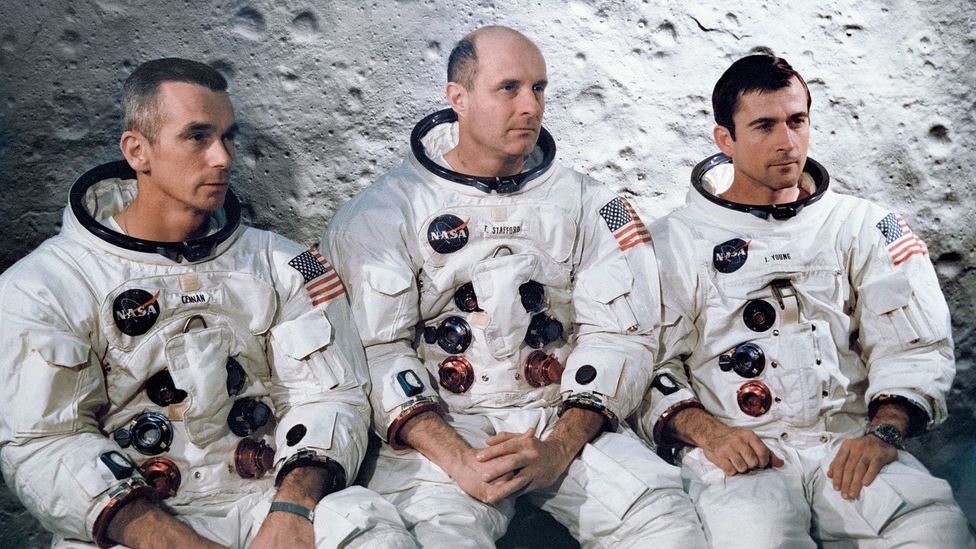
The Apollo ten astronauts are probably the fastest humans in history - but for how long? (Nasa)
The inherent survivability of the superluminal realm, though speculative, isn't without some educated shots in the dark. One intriguing faster-than-light scenario works like the "warp drive" of Star Trek. Called an Alcubierre bulldoze, it involves compressing the normal spacetime described by Einsteinian physics in front of a star send, while expanding information technology backside. In essence, the ship resides within a clamper of spacetime – a "warp chimera" – that moves faster than the speed of light. The send, however, remains at residue within its pocket of normal spacetime, avoiding any violation of the universal light-speed limit. "Instead of swimming through the water" of normal spacetime, says Davis, the Alcubierre drive "will carry you similar a surfer riding on the crest of wave on a surfboard".
The catch: the concept requires an exotic form of matter possessing a negative mass to contract and expand spacetime. "Physics doesn't forbid negative mass," says Davis, "but there are no examples of it and we've never seen it in nature." The other catch: a 2012 paper by University of Sydney researchers suggests that the warp chimera would gather up high-free energy cosmic particles as information technology inevitably interacted with the Universe'due south contents. Some particles would leak into the bubble itself, blasting the transport with radiation.
Stuck at sub-light?
Are we forever stuck at sub-low-cal velocities because of our frail biology? The reply matters not just for setting a new human being world (galactic?) speed record, but for the prospect of our species ever becoming an interstellar gild. At the half-light speed limit that Edelstein's research places on our bodies, a voyage to the nearest star is more than a sixteen-year round-trip. (Time dilation effects, wherein less time would pass for the hurtling star ship coiffure with their reference frame than for people back habitation on Earth in a different reference frame, would not exist a dramatic effect at one-half-low-cal speed.)
Millis holds out hope. Seeing equally humanity has invented loftier-Thou suits and micrometeoroid shielding to allow condom travel at terrific speeds in the corking blue yonder and the star-studded black of infinite, he thinks we volition devise ways to survive whatsoever velocity frontiers we face next.
"The kind of technologies that could enable unforeseeable new transit speeds, if future physics finds out that such engineering is possible," Millis says, "would likewise requite u.s.a. new, unforeseen possibilities for protecting crews."
Follow u.s. on Facebook , Twitter , Google+ and LinkedIn .
0 Response to "Fastest Speed That a Human Has Traveled"
Post a Comment